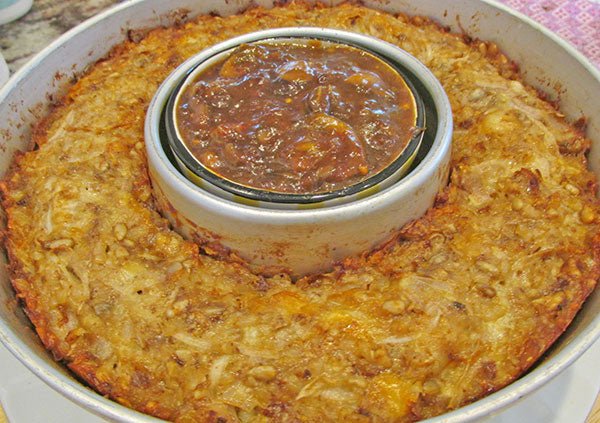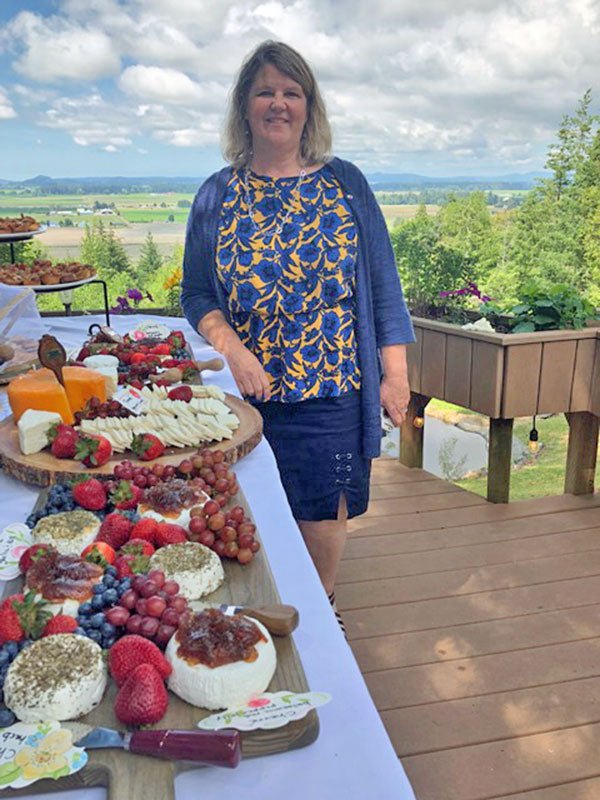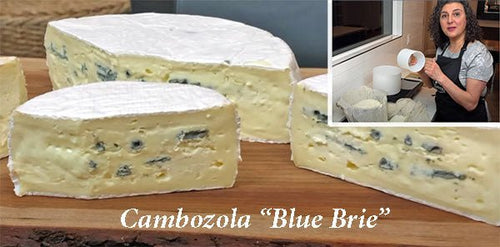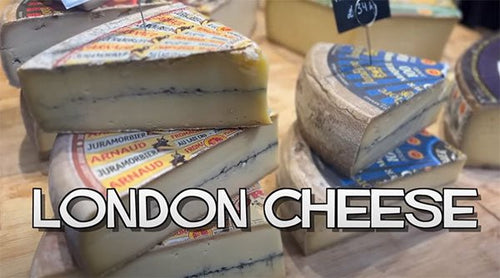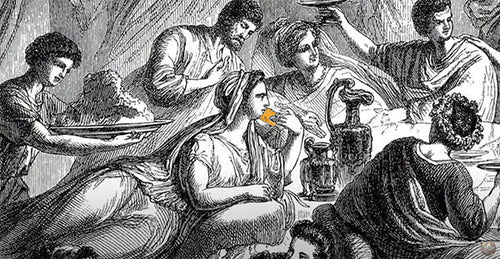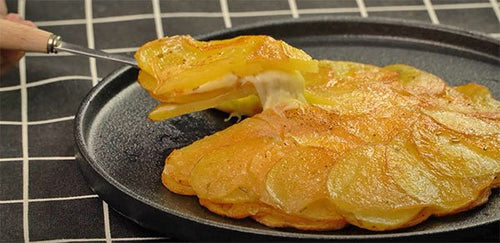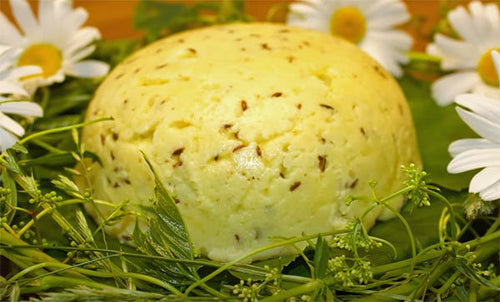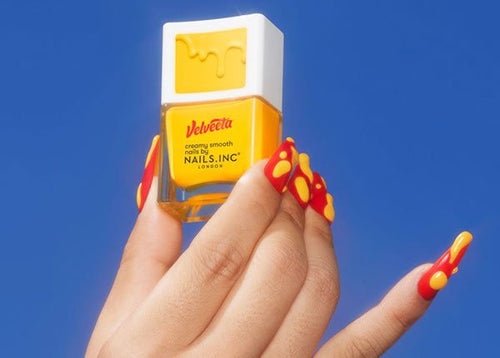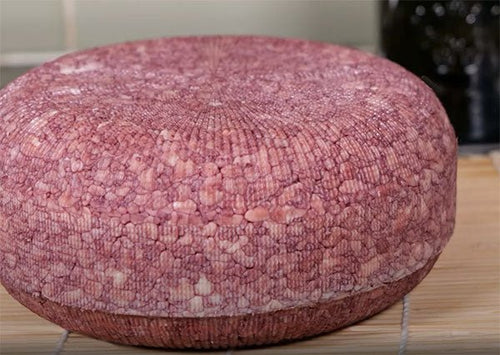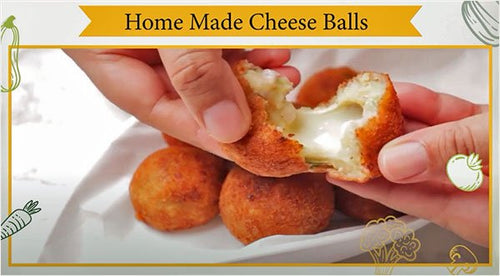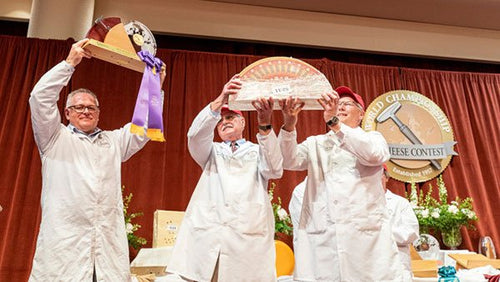
Logan, Ashley, Alanna, and their dog, Bella
About a month ago, Ashley made a comment at one of our blog articles (about freezing milk). She said she freezes her goat’s milk all the time to make cheese and has never had any problems with it. I contacted her to find out what kind of cheese she was making and I was pleasantly surprised to discover she makes a very wide variety. (It’s always fun to meet a master home cheese maker, filling her cave with all kinds of cheese and using our recipes.)

Ashley’s cave – a converted refrigerator
I thought her cheese making skills were enough to make her interesting, but when I went to her website, I discovered that she is gifted with an amazing variety of other skills.
Check out this list because she loves to barter and you can contact her at wrightashley73@gmail.com
-
- She has a small family farm (37’s Miniature Farm) and she occasionally sells goats, bees, hatching eggs, compost/manure and Alpaca fiber.
- She plays the violin and the viola.
- She teaches kids and adults to play those instruments. (Wright String Studio)
- She tutors math.
- She shears and offers other animal care services.
- She spins and weaves baskets and rugs.
- She makes soap.
- She edits.
- She designs websites.

How many hours are there in a day?!!! There could be at least 10 separate articles about Ashley, but because we are all about cheese making, I asked her a few questions about that:
How did you get started making cheese?
It all started with goats. I fell in love with goats in high school, volunteering at the zoo, but the big goats freaked me out (the zoo had pygmies) and I didn’t know about Nigerian Dwarf goats at the time. So thought you couldn’t milk little goats, but didn’t see the point in just pet goats.
So, I temporarily gave up on the idea, until interning at a different zoo in college that did have NDGs. And I knew those were the goats for me. So, when I got my pasture fenced and my barn built several years later, I bought a couple goats.

Alanna and Logan, with Annie
My mom had recently started making cheese, and she encouraged me to try it, saying I could just use lemon juice. So, I did, and I’m sure I made a lot of mistakes – didn’t use enough milk, didn’t heat properly, wrong amount of lemon juice, etc, but in any case, I was unimpressed with the results. All I made was an unsatisfying mess.
I finally bit the bullet and tried using actual chevre culture from you guys, and haven’t looked back! I found success!
From there, I expanded to hard cheeses. A friend offered me an old freezer she didn’t need, so I sold my fish tank to make room for my new cheese cave.
I started with one of your starter sets, and first tried the cheddar recipe that came in the booklet. Those were some HARD cheeses!! They were so rock hard we used them as parmesan.
I then tried your gouda recipe, and found a little more success with that, and started exploring why my cheeses were so much different than I was expecting. I’ve made a number of changes in my cheese making since I started, and while I still don’t get cheese like what you buy at the store, mine are delicious and everyone seems to love them.

Her son when he was smaller, with Agate at right and Belle at left.
Do you still have your Nigerian Dwarfs?
When I started, I had NDGs, but soon realized I wasn’t getting enough milk. I was having to freeze milk in order to get enough to make cheese, and then I was using the bare minimum of 2 gallons (part of the reason my cheeses were turning out so hard).
I’d also been hearing a lot about kiko goats and how hardy they were, so after doing some more research decided to try one. They’re supposed to be a meat goat, but I’d read they were bred from feral dairy goats, so thought I’d try milking one. My kiko doe that I got is now my herd queen, and while her lactation isn’t as long as my alpine/saanen doe’s, and she doesn’t produce as much, she does give me over a gallon a day during peak production of really thick, high fat milk, much like a NDG’s.

My third doe, I bred here on the farm; she’s an even mix of Nigerian, kiko, alpine, and saanen. Medium sized with medium sized teats, her milk has more fat than the alpine/saanen. She doesn’t give as much, but I breed her in the spring so she gives me milk all winter long while my other two does are producing less milk. She’s also the doe my kids will get to learn to milk on if they ever want to.

Agate (a kiko) and her kids
What kinds of cheese have you made so far?
The cheese that really taught me how to make a better cheese was the drunken goat (Cabra al Vino). I was in love with the fact that it was supposed to be made with raw goat’s milk, but I didn’t like that it used 1/2 packages. The perfectionist part of me hated trying to split a package of culture in half. So now I kind of make a hybrid between the drunken goat and gouda. I use 1 package of mesophilic culture (usually; sometimes during the summer I use thermophilic), but I don’t really follow a recipe. When the kids were younger, I was having to time everything around when they needed to be nursed or changed or put down for a nap, and we called it the “2 under 2 cheese.”
Let’s see, other cheeses I have tried: did a wine-infused cheese once, but my pressing setup isn’t good for a lot of weight and that one required over 50 lbs if I remember correctly, so haven’t done that one again.

Ashley’s husband made this press. “I used to balance books on the cheese while it was sitting in the sink (it wasn’t until later I found out how bad the whey is for our septic system), and they were forever falling off and needing readjustment. So he made me this setup, which still doesn’t allow a ton of weight, but the books fall off less. And, I’m not flooding my septic system with whey.”
Tried 2 aged soft cheeses (belper knolle and caciocavallo) and either because of my technique or the fact that my first cheese cave grew mold like nobody’s business (or both), those both turned into nasty moldy messes that I never ate.
This year, I’ve been having fun taking what has become my usual “farmstead cheese” (I guess; I don’t follow a recipe so I have a hard time giving it a name) and adding things to it. My favorite for delectable snacking is my chocolate cheese (add dark chocolate chunks to the curds when you put them in the mold, then use the chocolate/pepper/coffee/olive oil rub), but that obviously isn’t good in many dishes requiring cheese. I’ve also added dried bell peppers (olive oil rub), dried garlic (also olive oil rub), peppers (pepper and olive oil rub), rosemary, sage, and thyme (made a rub for each of the herbs and applied accordingly).
This summer I was making a LOT of cheese, like, 3-5 cheeses a week, and I made so many they didn’t fit on the four boards I had for them. So I made 2 new shelves for the cheese cave, which are in use in one of the pictures of my cave. The other picture has the four original boards in use.

“Upper right, in the front, are 2 pepper cheeses. The one on the left is younger (with less pepper rub on it) than the one on the right. Behind them are the herb cheeses, and you can’t really see if but there’s a wine cheese in the back left corner. On the right hand side on the top are the chocolate cheeses. Bottom left are wine cheeses, bottom right are plain cheeses that maybe came out of the mold a little funky, or developed some cracks, or for whatever reason I deemed not worthy of the wine soak. (I feel like the wine soak helps a little in preventing mold, so tend to do that with cheeses I think I’ll be aging for a while. If I want to eat them sooner, I don’t soak them.) In the door on the left are cheeses in their wine soak.”
How did you learn?
I actually haven’t taken any classes. After buying the first kit, and not getting the cheeses I was wanting, I did a lot of research, read a LOT on the internet, tried to read a couple cheese making books but they were really too technical for me, and just tried different things. With 3 goats in milk now, I’m getting a lot of milk, so if I have a few cheeses that don’t turn out, I don’t fret. It frees me up to experiment a bit, because I’m not as afraid of screwing them up.

What are your goals for your cheese making?
My goal used to be to make all the cheese we needed, so we didn’t have to buy any cheese. But I’ve since come to accept that I just will not be making a decent cheddar, and having grown up on Tillamook cheddar, there are just some meals, like tacos and chili, that in my mind require cheddar. So we still buy the occasional cheese. But I’m able to keep us mostly in supply.
Over the summer, I wanted to fill up my cheese cave (that’s 36 cheeses!). I didn’t quite get there, but almost. I try to empty out my cheese cave each winter, which is definitely more fun than filling it. I was hoping to be pretty much done making cheese for the year, but my goats still produce more milk than we can drink, so I’ve been making cheese about once a week lately.
I enjoy serving my cheese at get-togethers and gifting it to family and friends, but I’ll never sell it. Besides all the red tape with selling dairy legally, I once tried to figure out how much I was spending (for feed) per gallon of milk produced. I stopped trying to figure it out when I was getting depressingly high figures like close to $20/gallon. There’s no way I could be comfortable with asking $60 for a wheel of cheese! Especially since every cheese is an experiment and I never know how it’s going to turn out. In fact, whenever I serve the cheese anywhere, I always cut it up first, so I can taste it without anyone realizing. That, and then I can make sure to remove any mold before serving.
So, I won’t be selling my cheese ever, but I enjoy making it and using the milk my goats produce. And I guess that’s my goal, now – to make the most from the milk produced on my farm, and be able to feed my family and friends yummy cheese.































